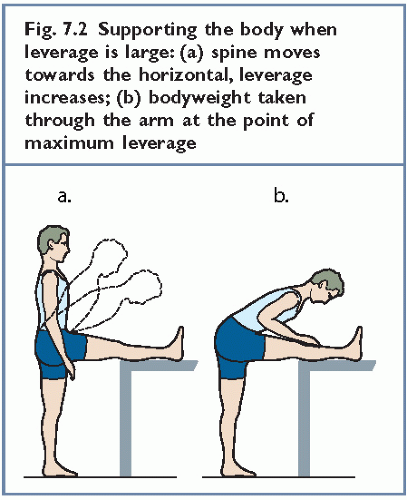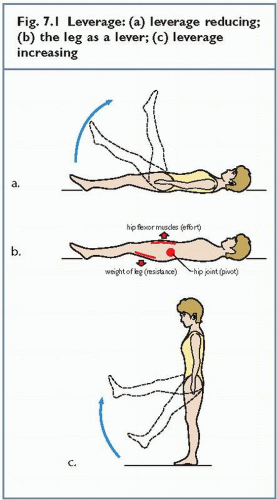Trunk Exercise Dangers
More than any other area in the body, the back is susceptible to injury through incorrect exercise. To prevent injury, we need to have an understanding of some basic mechanical concepts.
Leverage
The limbs and spine act as levers when we move. A lever is simply a rigid bar which moves around a fixed point or pivot. Two forces act on the lever: effort and resistance. The effort tries to move the lever, while the resistance tries to stop movement. In the body, the effort is supplied by your muscles, while the resistance is the weight of the moving body part. Take as an example the leg lifting from a lying position. The pivot is the hip joint, the effort is supplied by the hip flexor muscles which lift the leg, and the resistance is the weight of the whole leg. The effort from the muscle acts at the point where the muscle attaches to the thighbone (see fig. 7.1b).
We say that the weight acts through a single point called the ‘centre of gravity’. This is really the balance point of the limb, and would be the centre point of the limb if the limb were the same size all over. However, because the leg is thicker at the top, the centre of gravity lies towards the heavier end.
Keypoint
The centre of gravity of a limb is its balance point.
Leverage is greater when there is a long horizontal distance between the pivot and the
point where the weight or effort acts. In fig. 7.1, the leverage is greatest when the leg first lifts from the ground, because it is close to the horizontal. As the leg lifts up, it moves away from the horizontal and so the leverage reduces and the exercise actually gets easier. In fig. 7.1c the subject is standing up with the legs in the vertical position. The leverage to begin with is minimal. As the leg lifts, however, it moves towards the horizontal and so the leverage increases. This is now the reverse situation to fig. 7.1a, and the exercise gradually gets harder. Although both exercises involve flexing the straight leg, the starting position of the movement changes the effect of the exercise considerably.
point where the weight or effort acts. In fig. 7.1, the leverage is greatest when the leg first lifts from the ground, because it is close to the horizontal. As the leg lifts up, it moves away from the horizontal and so the leverage reduces and the exercise actually gets easier. In fig. 7.1c the subject is standing up with the legs in the vertical position. The leverage to begin with is minimal. As the leg lifts, however, it moves towards the horizontal and so the leverage increases. This is now the reverse situation to fig. 7.1a, and the exercise gradually gets harder. Although both exercises involve flexing the straight leg, the starting position of the movement changes the effect of the exercise considerably.
Keypoint
Leverage is greatest when a lever is in a horizontal position.
This example has important implications with regards to the safety of the spine. Exercises which involve moving the spine into a horizontal position will place great amounts of leverage on the spine and should be used with caution. Often, simply altering the starting position will move the spine away from the horizontal and so reduce the stress on the lower back. Where a horizontal position must be used, the spine should be supported. As an example of this process let’s look at a common stretch for the hamstring muscles on the back of the thigh. In fig. 7.2a an athlete is stretching the hamstrings by bending the trunk forwards from the hip. This action places an excessive leverage stress on the spine because it is moving from a vertical position (minimal leverage) to a more horizontal position (maximum leverage). Simply by placing one hand down on the knee, the spine is supported and the stress reduced (see fig. 7.2b).
 Fig. 7.2 Supporting the body when leverage is large: (a) spine moves towards the horizontal, leverage increases; (b) bodyweight taken through the arm at the point of maximum leverage |
Keypoint
If an exercise doesn’t allow you to keep your spine vertical, place your hand on something for support.
Which body area is moving?
Often, a quick look at an exercise creates the impression that a particular part of the body is moving. On closer inspection, however, it can be seen that other body areas are also moving and these may be taking greater stress than is intended. This holds true particularly with the pelvis moving on the spine or hip. Take as an example a stretch for the thigh muscles (see fig. 7.3). The subject is standing up straight and has grasped the ankle. She is pulling the hip backwards and trying to increase the bend on the knee at the same time. At first sight this seems
to be an exercise which is simply placing the thigh muscles into a stretch. However, if we look closely we can see that the pelvis has tilted forwards and stress is now placed on the spine. In this case the spine is more flexible than the tight thigh muscles, so the more the stretch is pushed, the more stress is thrown onto the spine.
to be an exercise which is simply placing the thigh muscles into a stretch. However, if we look closely we can see that the pelvis has tilted forwards and stress is now placed on the spine. In this case the spine is more flexible than the tight thigh muscles, so the more the stretch is pushed, the more stress is thrown onto the spine.
 Fig. 7.3 (a) Normal pelvic tilt and lower back alignment; (b) pelvis moves excessively, causing lower back to hollow: leg goes higher, but technique is faulty |
If we look at fig. 7.4, the subject is trying to touch her toes by stretching her hamstrings (behind the thigh). In fig. 7.4b she appears to be stretching further because she has reached closer to her toes. However, if we look at the line of the pelvis, the subject has moved exactly the same amount both times. The extra movement in fig. 7.4b has occurred by over-bending the upper spine. Again, this part of the body is generally more flexible than the tight hamstrings. As the movement is pushed further and further, the stretch on the hamstrings will not increase, but the stress on the upper spine certainly will.
Stay updated, free articles. Join our Telegram channel

Full access? Get Clinical Tree









